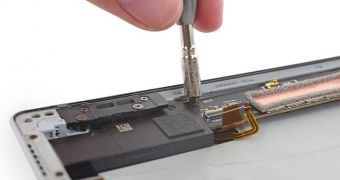Microsoft has just announced a partnership with famous website iFixit, which tests and determines the repairability of almost every single device that hits the shelves these days, to provide users with information on how to fix specific gadgets, such as mobile phones, tablets, and laptops.
Redmond says that the company has already prepared several training services for people who want to start a small business, offering repair services for these products, and thanks to sponsorship coming through the Registered Refurbisher Program, anyone can learn how to fix a broken tablet.
“Devices like phones and tablets are often used intermittently by consumers. This, combined with their very low power consumption means they use relatively minimal electrical power over their lifetime,” Microsoft has said in a press statement today.
“However, the process to manufacture these devices, which relies on raw materials and energy, is often a significantly larger amount of power consumption. Some studies have suggested that you would need to use a tablet or phone for tens of years before the usage footprint was larger than the manufacturing footprint. With this in mind, anything that can be done to extend the life of these smaller, low-power devices can have a positive environmental benefit.”
Microsoft claims that, thanks to such services, the live of the gadgets we use every day, including here phones, tablets, and laptops, can be significantly extended. As a result, these devices can then be brought back into production, thus fueling the concept of circular economy.
“Ideally, if more local people offer repair, refurbishment and recycling services, more of these valuable resources can be driven back into the production cycle, supporting the idea of a circular economy. In this type of system, everything we use gets reused and recycled, reducing our need for virgin raw materials,” the company has pointed out.
iFixit has already tested most Microsoft devices to determine their repairability score, including the newly launched Surface Pro 3. The Surface Pro 3 got a rating of 1 out of 10, with 10 being the easiest to repair.
Engineers explain that Microsoft used “tons of adhesive” to hold everything in place, including the display and the battery, while the display itself is made of a fused glass panel and an LCD, which makes it nearly impossible to remove and replace without super skills. Last but not least, iFixit says that it’s very difficult to open the device and with “one slip-up you’ll be out a screen.”

 14 DAY TRIAL //
14 DAY TRIAL //